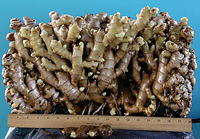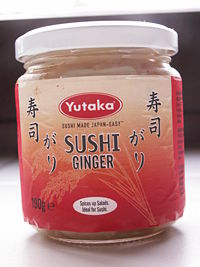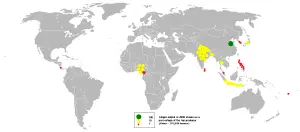Ginger
| Zingiber officinale | ||||||||||||||
|---|---|---|---|---|---|---|---|---|---|---|---|---|---|---|
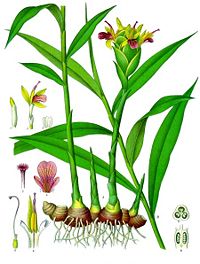 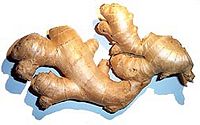 | ||||||||||||||
|
Secure
| ||||||||||||||
| Scientific classification | ||||||||||||||
| ||||||||||||||
| Zingiber officinale Roscoe[1] |
Ginger is the common name for the monocotyledonous perennial plant Zingiber officinale, an erect plant in the Zingiberaceae family that is widely cultivated for its edible, underground rhizome (horizontal stem). The term also is used to refer to this pungent, aromatic rhizome, which is commonly dried and prepared as a popular spice, and is sometimes referred to as gingerroot. In a broader sense, the term ginger can be applied to all plants in the genus Zingiber (the "true gingers"), and the Zingiberaceae family is known as the ginger family.
Description
Zingiberaceae, the "Ginger family," is a family of flowering plants consisting of aromatic perennial herbs with creeping horizontal or tuberous rhizomes, comprising ca. 52 genera and more than 1300 species, distributed throughout tropical Africa, Asia and the Americas.
Many species are important ornamental plants, spices, or medicinal plants. Ornamental genera include the shell gingers (Alpinia), Siam or summer tulip (Curcuma alismatifolia), Globba, ginger lily (Hedychium), Kaempferia, torch-ginger Nicolaia, Renealmia, and ginger (Zingiber). Spices include ginger (Zingiber), galangal or Thai ginger (Alpinia galanga and others), melegueta pepper (Aframomum melegueta), myoga (Zingiber mioga), turmeric (Curcuma), cardamom (Amomum, Elettaria).
Characteristics
Members of the family are small to large herbaceous plants with distichous leaves with basal sheaths that overlap to form a pseudostem. The plants are either self-supporting or epiphytic. Flowers are hermaphroditic, usually strongly zygomorphic, in determinate cymose inflorescences, and subtended by conspicuous, spirally arranged bracts. The perianth is comprised of 2 whorls, a fused tubular calyx, and a tubular corolla with one lobe larger than the other two. Flowers typically have two of their stamenoids (sterile stamens) fused to form a petaloid lip, and have only one fertile stamen. The ovary is inferior and topped by two nectaries, the stigma is funnel-shaped.
Some genera yield essential oils used in the perfume industry (Alpinia, Hedychium).
Distribution
The Zingiberaceae has a pantropical distribution—found in the tropics of Africa, Asia and the Americas—with its greatest diversity in Southeast Asia.
Often referred to as ginger "root", the edible section is actually a rhizome. The ginger plant has a long history of cultivation known[citation needed] to originate in China and then spread to India, Southeast Asia, West Africa, and the Caribbean.[2]
Etymology
Latin gingiber via Sanskrit from Tamil இஞ்ஜி வேர் (inji), a word for ginger plant's root or Malayalam (inchi)
Chemistry
Ginger contains up to 3% of an essential oil that causes the fragrance of the spice. The main constituents are sesquiterpenoids with (-)-zingiberene as the main component. Lesser amounts of other sesquiterpenoids (β-sesquiphellandrene, bisabolene and farnesene) and a small monoterpenoid fraction (β-phelladrene, cineol, and citral) have also been identified.
The pungent taste of ginger is due to nonvolatile phenylpropanoid-derived compounds, particularly gingerols and shogaols. The latter are formed from the former when ginger is dried or cooked. Zingerone is also produced from gingerols during this process, and it is less pungent and has a spicy-sweet aroma.[3] Ginger is also a minor chemical irritant, and because of this was used as a horse suppository by pre-World War I mounted regiments for figging.
Ginger has a sialagogue action, stimulating the production of saliva.
Culinary uses
| Ginger root, raw Nutritional value per 100 g | ||||||||||||||||||||||||||||||||||
|---|---|---|---|---|---|---|---|---|---|---|---|---|---|---|---|---|---|---|---|---|---|---|---|---|---|---|---|---|---|---|---|---|---|---|
| Energy 20 kcal 80 kJ | ||||||||||||||||||||||||||||||||||
| ||||||||||||||||||||||||||||||||||
| Percentages are relative to US recommendations for adults. Source: USDA Nutrient database | ||||||||||||||||||||||||||||||||||
Young ginger rhizomes are juicy and fleshy with a very mild taste. They are often pickled in vinegar or sherry as a snack or just cooked as an ingredient in many dishes. They can also be stewed in boiling water to make ginger tea, to which honey is often added as a sweetener; sliced orange or lemon fruit may also be added. Mature ginger roots are fibrous and nearly dry. The juice from old ginger roots is extremely potent and is often used as a spice in Chinese cuisine to flavor dishes such as seafood or mutton. Powdered dry ginger root (ginger powder) is typically used to add spiciness to gingerbread and other recipes. Ground and fresh ginger taste quite different and ground ginger is a poor substitute for fresh ginger. Fresh ginger can be successfully substituted for ground ginger and should be done at a ratio of 6 parts fresh for 1 part ground.
Ginger is also made into candy and used as a flavoring for cookies, crackers and cake, and is the main flavor in ginger ale— a sweet, carbonated, non-alcoholic beverage, as well as the similar, but somewhat spicier beverage ginger beer.
Regional uses
In Western cuisine, ginger is traditionally restricted to sweet foods, such as ginger ale, gingerbread, ginger snaps, ginger cake and ginger biscuits. A ginger-flavored liqueur called Canton is produced in Jarnac, France. Green ginger wine is a ginger flavored wine produced in the United Kingdom, traditionally sold in a green glass bottle. Ginger is also used as a spice added to hot coffee and tea.
In Arabic, ginger is called Zanjabil and in some parts of the Middle East ginger powder is used as a spice for coffee.
In India, ginger is called "Aadu" in Gujarati, "Shunti" in Kannada language[Karnataka], Allam in Telugu, Inji in Tamil and Malayalam, Alay in Marathi and Adrak in Hindi and Urdu. Fresh ginger is one of the main spices used for making pulse and lentil curries and other vegetable preparations. It is used fresh to spice tea especially in winter. Also, ginger powder is used in certain food preparations that are made particularly for expecting women and feeding mothers, the most popular one being Katlu which is a mixture of gum resin, ghee, nuts and sugar.
In south India, ginger is used in the production of a candy called Inji-murappa ("ginger candy" from Tamil). This candy is mostly sold by vendors to bus passengers in bus stops and in small tea shops as a locally produced item. Candied ginger is also very famous around these parts. Additionally, in Tamil Nadu, especially in the Tanjore belt, a variety of ginger which is less spicy is used when tender to make fresh pickle with the combination of lemon juice or vinegar, salt and tender green chillies. This kind of pickle was generally made before the invention of refrigeration and stored for a maximum of 4-5 days. The pickle gains a mature flavor when the juices cook the ginger over the first 24 hours. Ginger is also added as a flavoring in tea.
In Japan, ginger is pickled to make beni shoga and gari or grated and used raw on tofu or noodles. It is also made into a candy called shoga no satozuke.
In Burma, ginger is used in a salad dish called gyin-tho, which consists of shredded ginger preserved in oil, and a variety of nuts and seeds.
Indonesia has a famous beverage that called Wedang Jahe, which is made from ginger and palm sugar; Indonesians also use ground ginger root, called jahe or djahe, as a frequent ingredient in local recipes.
In traditional Korean kimchi, ginger is finely minced and added to the ingredients of the spicy paste just before the fermenting process.
In South East Asia, the flower of a type of ginger is used in cooking. (questionable as fact) This unopened flower is known in the Malay language as Bunga Kantan, and is used in salads and also as garnish for sour-savoury soups, like Assam Laksa.
In the Ivory Coast, ginger is ground and mixed with orange, pineapple and lemon to produce a juice called Nyamanku.
In China, sliced or whole ginger root is often paired with savory dishes, such as fish. However, candied ginger is sometimes a component of Chinese candy boxes, and an herbal tea can also be prepared from ginger.
Medical uses
The medical form of ginger historically was called "Jamaica ginger"; it was classified as a stimulant and carminative, and used frequently for dyspepsia and colic. It was also frequently employed to disguise the taste of medicines. Ginger is on the FDA's 'generally recognized as safe' list, though it does interact with some medications, including warfarin. Ginger is contraindicated in people suffering from gallstones as the herb promotes the release of bile from the gallbladder.[4] Ginger may also decrease joint pain from arthritis, though studies on this have been inconsistent, and may have blood thinning and cholesterol lowering properties that may make it useful for treating heart disease. [5]
The characteristic odor and flavor of ginger root is caused by a mixture of zingerone, shoagoles and gingerols, volatile oils that compose about one to three percent of the weight of fresh ginger. In laboratory animals, the gingerols increase the motility of the gastrointestinal tract and have analgesic, sedative, antipyretic and antibacterial properties [6]
Diarrhea
Ginger compounds are active against a form of diarrhea which is the leading cause of infant death in developing countries. Zingerone is likely to be the active constituent against enterotoxigenic Escherichia coli heat-labile enterotoxin-induced diarrhea. [7]
Nausea
Ginger has been found effective by multiple studies for treating nausea caused by seasickness, morning sickness and chemotherapy,[8] though ginger was not found superior over a placebo for post-operative nausea.
Folk medicinal uses
There are a variety of uses suggested for ginger. Tea brewed from ginger is a folk remedy for colds. Ginger ale and ginger beer have been recommended as "stomach settlers" for generations in countries where the beverages are made and ginger water was commonly used to avoid heat cramps in the US. Ginger has also been historically used to treat inflammation which several scientific studies support, though one arthritis trial showed ginger to be no better than a placebo or ibuprofen.[5] Research on rats suggests that ginger may be useful for treating diabetes.[9][10]
Local uses
In the West, powdered dried ginger root is made into capsules and sold in pharmacies for medicinal use.
- In the United States, ginger is generally recognized as safe by the Food and Drug Administration, though it is not approved for the treatment or cure of any disease and is sold as an unregulated dietary supplement
- In India, ginger is applied as a paste to the temples to relieve headache and consumed when suffering from a cold,people use ginger for making tea, in food etc.
- In Burma, ginger and a local sweetener made from palm tree juice (Htan nyat) are boiled together and taken to prevent the flu
- In China, a drink made with sliced ginger cooked in sweetened water or a cola is used as a folk medicine for common cold[11]
- In Indonesia, a type of ginger known as Jahe is used as a herbal preparation to reduce fatigue, reducing "winds" in the blood, prevent and cure rheumatism and controlling poor dietary habits
- In Democratic Republic of the Congo, ginger is crushed and mixed with mango-tree sap to make Tangawisi juice, which is considered as a universal panacea
- In the Philippines a traditional health drink called "salabat" is made for consumption with breakfast by boiling chopped ginger and adding sugar
Reactions
Allergic reactions to ginger generally result in a rash and though generally recognized as safe, ginger can cause heartburn, bloating, gas, belching and nausea, particularly if taken in powdered form. Unchewed fresh ginger may result in intestinal blockage, and individuals who have had ulcers, inflammatory bowel disease or blocked intestines may react badly to large quantities of fresh ginger.[12] Ginger can also adversely affect individuals with gallstones.[5][12] There are also suggestions that ginger may affect blood pressure, clotting, and heart rhythms.[12]
Horticulture
Ginger produces clusters of white and pink flower buds that bloom into yellow flowers. Because of the aesthetic appeal and the adaptivity of the plant to warm climates, ginger is often used as landscaping around subtropical homes. It is a perennial reed-like plant with annual leafy stems, three to four feet high.
Historical methods of gathering the root describes, when the stalk withers, it is immediately scalded, or washed and scraped, in order to kill it and prevent sprouting. The former method, applied generally to the older and poorer roots, produces Black Ginger; the latter, gives White Ginger. The natural color of the "white" scraped ginger is a pale buff—it is often whitened by bleaching or liming, but generally at the expense of some of its real value.
Production trends
In 2005, China continued to lead the world in ginger production with a global share of almost 25% followed by India, Nepal and Indonesia.
| Top Ten Ginger Producers — 2005 | ||||
|---|---|---|---|---|
| Country | Production (Int $1000) | Footnote | Production (MT) | Footnote |
| 133,811 | C | 275,000 | F | |
| 130,964 | C | 230,000 | F | |
| 85,981 | C | 151,000 | F | |
| 62,635 | C | 110,000 | F | |
| 53,525 | C | 94,000 | F | |
| Template:BAN | 27,332 | C | 48,000 | F |
| 19,360 | C | 34,000 | F | |
| 12,911 | C | 22,675 | F | |
| 4,271 | C | 7,500 | F | |
| 3,399 | C | 5,970 | F | |
| No symbol = official figure,F = FAO estimate, * = Unofficial figure, C = Calculated figure; Production in Int $1000 have been calculated based on 1999-2001 international prices | ||||
Similar species
Myoga (Zingiber mioga Roscoe) appears in Japanese cuisine; the flower buds are the part eaten.
Another plant in the Zingiberaceae family, galangal, is used for similar purposes as ginger in Thai cuisine. Galangal is also called Thai ginger. Also referred to as galangal, fingerroot (Boesenbergia rotunda), or Chinese ginger or the Thai krachai, is used in cooking and medicine.
A dicotyledonous native species of eastern North America, Asarum canadense, is also known as "wild ginger", and its root has similar aromatic properties, but it is not related to true ginger. The plant also contains aristolochic acid, a carcinogenic compound.
ReferencesISBN links support NWE through referral fees
- ↑ Zingiber officinale information from NPGS/GRIN. www.ars-grin.gov. Retrieved 2008-03-03.
- ↑ Spices: Exotic Flavours & Medicines: Ginger. Retrieved 2007-08-08.
- ↑ McGee, Harold (2004). On Food and Cooking: The Science and Lore of the Kitchen (2nd ed.). New York: Scribner pp. 425-426.
- ↑ Al-Achi, Antoine. A Current Look at Ginger Use. Retrieved 2007-08-02.
- ↑ 5.0 5.1 5.2 University of Maryland Medical Centre (2006). Ginger. Retrieved 2007-08-02.
- ↑ MD O' Hara, Mary and & MSt; David Kiefer, MD; Kim Farrell, MD; Kathi Kemper, MD, MPH (1998). A Review of 12 Commonly Used Medicinal Herbs. Archives of Family Medicine (7): 523-536.
- ↑ Chen, Jaw-Chyun and Li-Jiau Huang, Shih-Lu Wu, Sheng-Chu Kuo, Tin-Yun Ho, Chien-Yun Hsiang (2007). Ginger and Its Bioactive Component Inhibit Enterotoxigenic Escherichia coli Heat-Labile Enterotoxin-Induced Diarrhea in Mice. Journal of Agricultural and Food Chemistry 55 (21): 8390–8397.
- ↑ Ernst, E. and & Pittler, M.H. (2000). Efficacy of ginger for nausea and vomiting: a systematic review of randomized clinical trials. British Journal of Anesthesia 84 (3): 367–371.
- ↑ Al-Amin, Zainab M. et al. (2006). Anti-diabetic and hypolipidaemic properties of ginger (Zingiber officinale) in streptozotocin-induced diabetic rats. British Journal of Nutrition 96: 660 - 666.
- ↑ Afshari, Ali Taghizadeh et al. (2007). The effect of ginger on diabetic nephropathy, plasma antioxidant capacity and lipid peroxidation in rats. Food Chemistry 101 (1): 148 - 153.
- ↑ Jakes, Susan (2007-01-15). Beverage of Champions. Retrieved 2007-08-02.
- ↑ 12.0 12.1 12.2 Mayo Clinic (2006-05-01). Drugs & Supplements: Ginger (Zingiber officinale Roscoe). Retrieved 2007-08-02.
Template loop detected: Template:Grocers
External links
- Medicinal uses of ginger
- Zingiber officinale List of Chemicals (Dr. Duke's)
- Gingers - Information about tropical gingers
| Herbs and spices | |
|---|---|
| Herbs | Angelica • Basil • Basil, holy • Basil, Thai • Bay leaf • Boldo • Borage • Cannabis • Chervil • Chives • Coriander leaf (cilantro) • Curry leaf • Dill • Epazote • Eryngium foetidum (long coriander) • Hoja santa • Houttuynia cordata (giấp cá) • Hyssop • Lavender • Lemon balm • Lemon grass • Lemon verbena • Limnophila aromatica (rice paddy herb) • Lovage • Marjoram • Mint • Mitsuba • Oregano • Parsley • Perilla (shiso) • Rosemary • Rue • Sage • Savory • Sorrel • Stevia • Tarragon • Thyme • Vietnamese coriander (rau răm) • Woodruff |
| Spices | African pepper • Ajwain (bishop's weed) • Aleppo pepper • Allspice • Amchur (mango powder) • Anise • Aromatic ginger • Asafoetida • Camphor • Caraway • Cardamom • Cardamom, black • Cassia • Cayenne pepper • Celery seed • Chili • Cinnamon • Clove • Coriander seed • Cubeb • Cumin • Cumin, black • Dill seed • Fennel • Fenugreek • Fingerroot (krachai) • Galangal, greater • Galangal, lesser • Garlic • Ginger • Grains of Paradise • Horseradish • Juniper berry • Liquorice • Mace • Mahlab • Malabathrum (tejpat) • Mustard, black • Mustard, brown • Mustard, white • Nasturtium • Nigella (kalonji) • Nutmeg • Paprika • Pepper, black • Pepper, green • Pepper, long • Pepper, pink, Brazilian • Pepper, pink, Peruvian • Pepper, white • Pomegranate seed (anardana) • Poppy seed • Saffron • Sarsaparilla • Sassafras • Sesame • Sichuan pepper (huājiāo, sansho) • Star anise • Sumac • Tasmanian pepper • Tamarind • Turmeric • Wasabi • Zedoary |
Credits
New World Encyclopedia writers and editors rewrote and completed the Wikipedia article in accordance with New World Encyclopedia standards. This article abides by terms of the Creative Commons CC-by-sa 3.0 License (CC-by-sa), which may be used and disseminated with proper attribution. Credit is due under the terms of this license that can reference both the New World Encyclopedia contributors and the selfless volunteer contributors of the Wikimedia Foundation. To cite this article click here for a list of acceptable citing formats.The history of earlier contributions by wikipedians is accessible to researchers here:
The history of this article since it was imported to New World Encyclopedia:
Note: Some restrictions may apply to use of individual images which are separately licensed.

